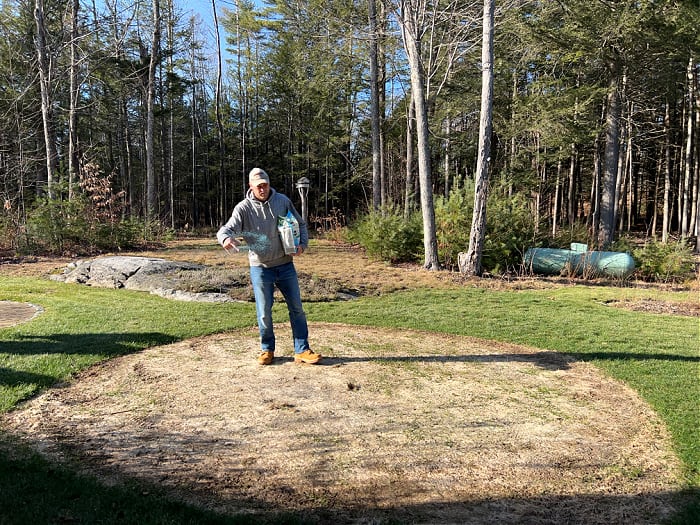Dormant Seeding over bare spots in your lawn is a great way to use the weather to your advantage.

What is Dormant Seeding?
Dormant seeding is when you apply seed to your lawn during colder months (fall-winter), when your cool season lawn is dormant.
The hope is that the newly applied seed will remain dormant and work its way down to the soil over several weeks or months. The rain, snow, and freeze and thaw action over the winter helps work the seed down into the soil and eventually the seed will germinate in the spring as soil temps warm.
With dormant seeding, you are taking away the need to prepare the existing soil for seeding as you would normally have to. Instead, you can fling seed directly over damaged or bare lawn areas and your work is done.
When to Apply
The best time to dormant seed your lawn is when soil temps are consistently below 50 degrees. You can check out Greencast to see when that normally is in your region.
It should be pretty obvious because at this point in the season your grass shouldn’t be growing and you should already have your last mow of the season in the books.
You also want all leaves cleaned up so seed can get into the soil instead of getting hung up on leaves.
Lastly, check the long term weather to make sure there isn’t a random warm stretch, torrential rain, or other forecast that can be bad for new seed.
Your ideal forecast should be consistently cool temperatures as you normally expect heading into winter. Snow, frost, or light rain is perfectly fine after seeding. In fact, if you can plan to seed right before a snowfall that would be ideal.
Benefits of Dormant Seeding
It may seem odd to apply seed so late in the year. Your surrounding landscape at this point isn’t showing a lot of signs of life, so why gamble and apply seed now, in hopes it will germinate in the spring?
The truth is there are a lot of benefits to dormant seeding:
1. Less Need to Water- Watering is definitely the hardest part of any lawn repair or renovation. Dormant seeding makes watering much easier. By the time the snow melts in early spring, the seed is already in the moist soil. With early spring rains on their way, there shouldn’t be as much of a need to irrigate. Of course, monitoring the weather and irrigating during dry spells is required.
2. Less Labor- One of the great perks of dormant seeding is the little effort required. Normal seeding methods require working the existing soil, bringing in new soil, or core aerating or dethatching to create voids in the soil for seed to fall into and make contact with the soil. With dormant seeding, you can literally throw seed on top of your lawn let nature do the rest.
3. Better Seed to Soil Contact- Good seed to soil contact is crucial for seed germination. With dormant seeding, the seed has plenty of time to make its way down into the soil. The natural cracking of the soil that occurs with frost opens the soil up even more, causing better seed to soil contact.
4. Earlier Jump Start in the Spring- Things happen quickly in the spring. It seems that all of a sudden out of no where, mother nature flips the switch and says its officially growing season. Having your seed already in the ground means the second the conditions are right in the spring your seed will begin to germinate. You don’t have to worry about squeezing in several hours of work in preparing soil for seeding.
5. Shady Areas Will Benefit- If trying to get grass to grow in shady areas, there’s a serious advantage to getting grass established before foliage appears on trees. Grass needs light to germinate, even fine fescues and other grasses that do well in shade once established. This window where grass can germinate before the foliage gets too big is small. Dormant seeding will allow you to get an early start in the spring and take full advantage of the pre foliage window.
6. Research Shows it Beats Spring Seeding- Research has actually proven that dormant seeding produces a healthier lawn for cool season grasses compared to spring seeding. This mostly has to do with the added time grass has to get established before facing harsh summer growing conditions.
Some Negatives
While there are many benefits to dormant seeding, there are some negatives to consider:
1. Unfavorable Winter Conditions- The biggest negative with dormant seeding is the risk involved in depending on favorable winter weather conditions. Cooler climates can usually expect several months of snow cover. This snow cover helps protect seed from washing away, drying out, or being eaten by wildlife. But for those winters that are more mild, or have less snow cover, seed loss is likely to be greater.
2. Birds and Other Wildlife- Grass seed is food for birds and other wildlife. If grass seed lays on top of your lawn, without the protection of snow cover, there’s a chance that birds and other wildlife will feed on it. This will decrease germination in the spring.
3. No Pre-Emergents In the Spring– One of the worst parts about dormant seeding is you have to hold off on applying pre emergent herbicides in the spring. Pre-emergent herbicides will block grass seed from germinating. Instead you’ll have to be more aggressive with Post Emergent herbicides to kill crabgrass and other broadleaf weeds throughout the season.
4. Nothing Beats Early Fall- Ultimately, dormant seeding is a way to get a little bit of a jump in early spring, preserve water, and labor, since you don’t have to prep existing soil. But overall you usually see higher germination rates by seeding in late summer/early fall immediately following core aeration, top dressing, and/or dethatching.
Overall, the best strategy for cool season lawns is to block weeds in spring with pre-emergents, stick to a good fertilizing program, and in late summer/early fall, if needed, apply seed to your lawn.
By late summer/early fall, cool season grasses thrive while weeds such as crabgrass start to fade.
Is Dormant Seeding Right for You?
You really have to consider the positives and negatives listed above. Dormant seeding can make a lot of sense if you have extra seed that you want to use up and and you are looking to make small improvements either to a section of your lawn or to your overall lawn. Maybe you have some damaged spots in your yard created by your dog, or you missed the seeding window in the late summer/early fall and want to incorporate some new seed to your lawn. In these scenarios it would be worth trying dormant seeding. If your lawn needs serious work however, and there are large bare sections you are looking to get established, you would be better off waiting until either spring, or late summer/early fall and doing a more traditional renovation. Seed is expensive and and you’ll get better germination rates by applying seed after top dressing, core aerating, and/or dethatching.
What Seed Works Best for Dormant Seeding?
Kentucky Bluegrass, Fescues, and Ryegrass are all good seed choices for dormant seeding. Using a mix of 2, or 3 different grass seeds is a great strategy. Nature will determine which grass seed prevails. A great place to purchase grass seed online is GCI Turf.
What is Frost Seeding?
Frost seeding is a type of dormant seeding. It is more specific in that it refers to spreading seed once the ground is frozen, not necessarily just when grass enters dormancy.
The thinking behind frost seeding is to take full advantage of the natural freeze thaw cycle. As freeze and thaw naturally occurs during the winter months, the seed gets worked into the soil through small cracks and heaves.
What is Snow Seeding?
Snow seeding is another type of dormant seeding. It refers to seeding your lawn after a light snowfall. The seed sits on top of the snow. As the snow melts the seed gets worked into the soil.
Snow seeding is the riskiest type of dormant seeding since seed on top of snow can become bird food.
Check Out These Posts Next
Winterizer Fertilizer: Everything You Need to Know
Top Dressing Lawn: Benefits and Advice
Lime Your Lawn: A Complete Guide
Lawn Dethatching: Everything You Need to Know
Follow Me
Join my free email list!


Will dog urine spots that look dead come back ? Or should they be totally removed ? And Reseeded with fresh dirt and grass seed
It really depends. Sometimes they can come back especially if you intervene early and water the spots or apply a dog urine remover product. Also if you have a spreading grass type such as Kentucky bluegrass or most warm season grasses you might see smaller spots fill in naturally. However, if you have spots that are completely fried I’d apply some fresh soil with some grass seed.